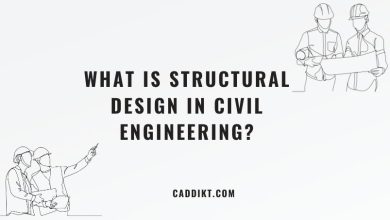Civil engineering is a diverse field that encompasses various disciplines, each contributing to the development and construction of infrastructure projects. From designing bridges and highways to constructing buildings and managing water resources, civil engineers play a crucial role in shaping our physical environment. In this article, we will explore the different types of civil engineering and highlight their significance in modern society.
Civil Engineering: An Overview
Civil engineering is a branch of engineering that deals with the design, construction, and maintenance of infrastructure projects. It involves the application of scientific and technical principles to ensure the safety, functionality, and sustainability of structures that serve society. Civil engineers work in both the public and private sectors, collaborating with architects, urban planners, and other professionals to create safe and efficient environments.
Structural Engineering
One of the primary disciplines within civil engineering is structural engineering. Structural engineers specialize in designing and analyzing structures to withstand loads and ensure their stability. They work on projects ranging from small buildings to large-scale infrastructure such as bridges, dams, and skyscrapers. By utilizing advanced materials and construction techniques, structural engineers ensure that structures can withstand various forces, including gravity, wind, earthquakes, and even human activities.
Geotechnical Engineering
Geotechnical engineering focuses on understanding the behavior of soil, rock, and other geological materials in relation to construction projects. Geotechnical engineers assess the stability and load-bearing capacity of the ground to determine the feasibility of building structures in a given location. They investigate soil properties, conduct geotechnical tests, and design foundations and retaining structures to ensure stability and prevent failures caused by soil movement or settlement.
Transportation Engineering
Transportation engineering deals with the planning, design, and operation of transportation systems. This branch of civil engineering encompasses various modes of transportation, including highways, railways, airports, and public transit systems. Transportation engineers analyze traffic patterns, optimize transportation networks, and design efficient and safe transportation infrastructure. They also consider environmental factors, such as reducing congestion and minimizing the impact on surrounding communities.
Environmental Engineering
Environmental engineering combines principles of civil engineering, chemistry, and biology to address environmental issues and promote sustainable practices. Environmental engineers work on projects related to water and wastewater treatment, air pollution control, solid waste management, and environmental impact assessments. Their role is vital in safeguarding natural resources, improving water quality, and mitigating the impact of human activities on the environment.
Water Resources Engineering
Water resources engineering focuses on managing and developing water-related projects, including dams, reservoirs, water supply systems, and flood control measures. Water resources engineers assess water availability, design irrigation systems, and develop strategies to manage water resources sustainably. They play a critical role in ensuring the efficient use of water and protecting communities from water-related disasters.
Construction Engineering
Construction engineering involves the planning, coordination, and execution of construction projects. Construction engineers work closely with architects, contractors, and project managers to ensure the successful completion of a project within budget and timeline constraints. They oversee construction activities, manage resources, and implement quality control measures to maintain project integrity. Construction engineering encompasses various aspects, including site development, project scheduling, and cost estimation.
Coastal Engineering
Coastal engineering deals with the design and management of coastal areas, focusing on shoreline protection, harbor development, and coastal infrastructure. Coastal engineers study wave dynamics, sediment transport, and erosion processes to develop strategies for coastal protection and restoration. They play a crucial role in preserving coastal ecosystems, enhancing navigation, and minimizing the impact of storms and sea-level rise on coastal communities.
Urban Planning
While not exclusively a branch of civil engineering, urban planning closely intersects with civil engineering principles. Urban planners collaborate with civil engineers to design and develop sustainable cities and communities. They consider various factors, including land use, transportation systems, environmental impact, and socio-economic considerations to create well-designed and functional urban spaces. Urban planners work alongside civil engineers to ensure that infrastructure projects align with the broader goals of urban development, including efficient transportation networks, green spaces, and sustainable growth.
Construction Management
Construction management is another vital aspect of civil engineering that focuses on overseeing the entire construction process. Construction managers coordinate and supervise construction projects, ensuring that they adhere to design specifications, safety regulations, and budgetary constraints. They collaborate with architects, engineers, contractors, and other stakeholders to ensure smooth project execution, resolve any issues that arise, and deliver projects on time.
Materials Engineering
Materials engineering plays a crucial role in civil engineering by studying the properties and behavior of construction materials. Materials engineers evaluate the strength, durability, and performance of materials used in infrastructure projects, such as concrete, steel, and asphalt. They conduct tests and experiments to determine the optimal materials and their composition, considering factors like load-bearing capacity, resistance to corrosion, and environmental impact.
Earthquake Engineering
Earthquake engineering focuses on designing structures and infrastructure to withstand seismic forces. Earthquake engineers assess the seismic hazard in a particular area, analyze the potential impact of earthquakes, and develop strategies to minimize damage and protect lives. They incorporate seismic-resistant design principles and technologies into structures, ensuring their resilience and safety during earthquakes.
Surveying and Geomatics
Surveying and geomatics are essential tools in civil engineering, providing accurate measurements and mapping of land and infrastructure. Surveyors use advanced equipment and techniques to measure and map the terrain, identify property boundaries, and collect data for construction and design purposes. Geomatics involves the collection, analysis, and interpretation of spatial data, including satellite imagery, GIS (Geographic Information Systems), and remote sensing, to support decision-making processes in civil engineering projects.
Conclusion
In conclusion, civil engineering encompasses various specialized disciplines that contribute to the planning, design, construction, and management of infrastructure projects. From structural engineering to transportation planning, environmental management to construction coordination, each branch plays a critical role in creating safe, sustainable, and functional environments. By understanding the different types of civil engineering, we gain a deeper appreciation for the expertise and efforts of civil engineers in shaping the world we live in. Their work ensures the development of robust infrastructure that enhances our quality of life and supports economic growth.








